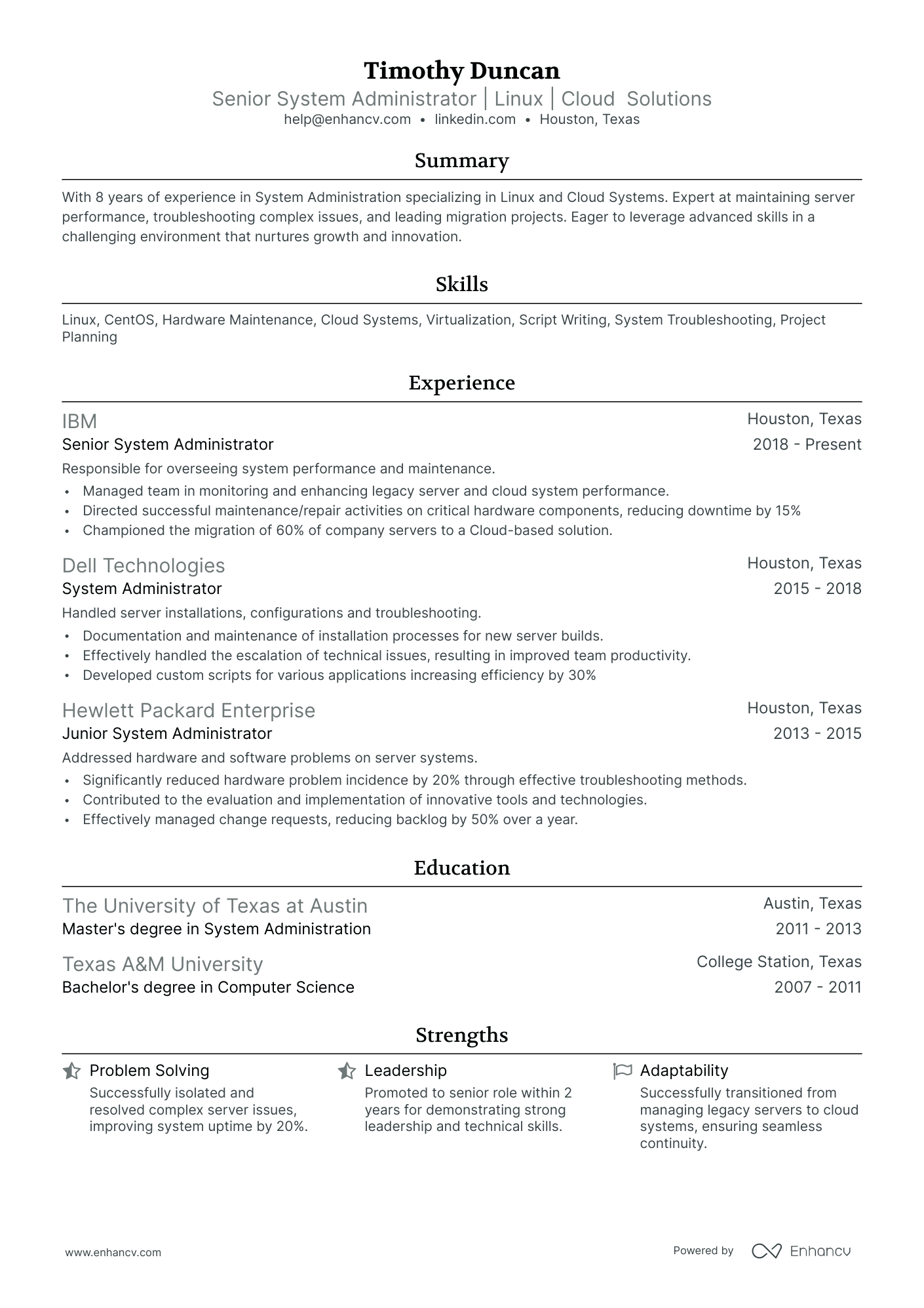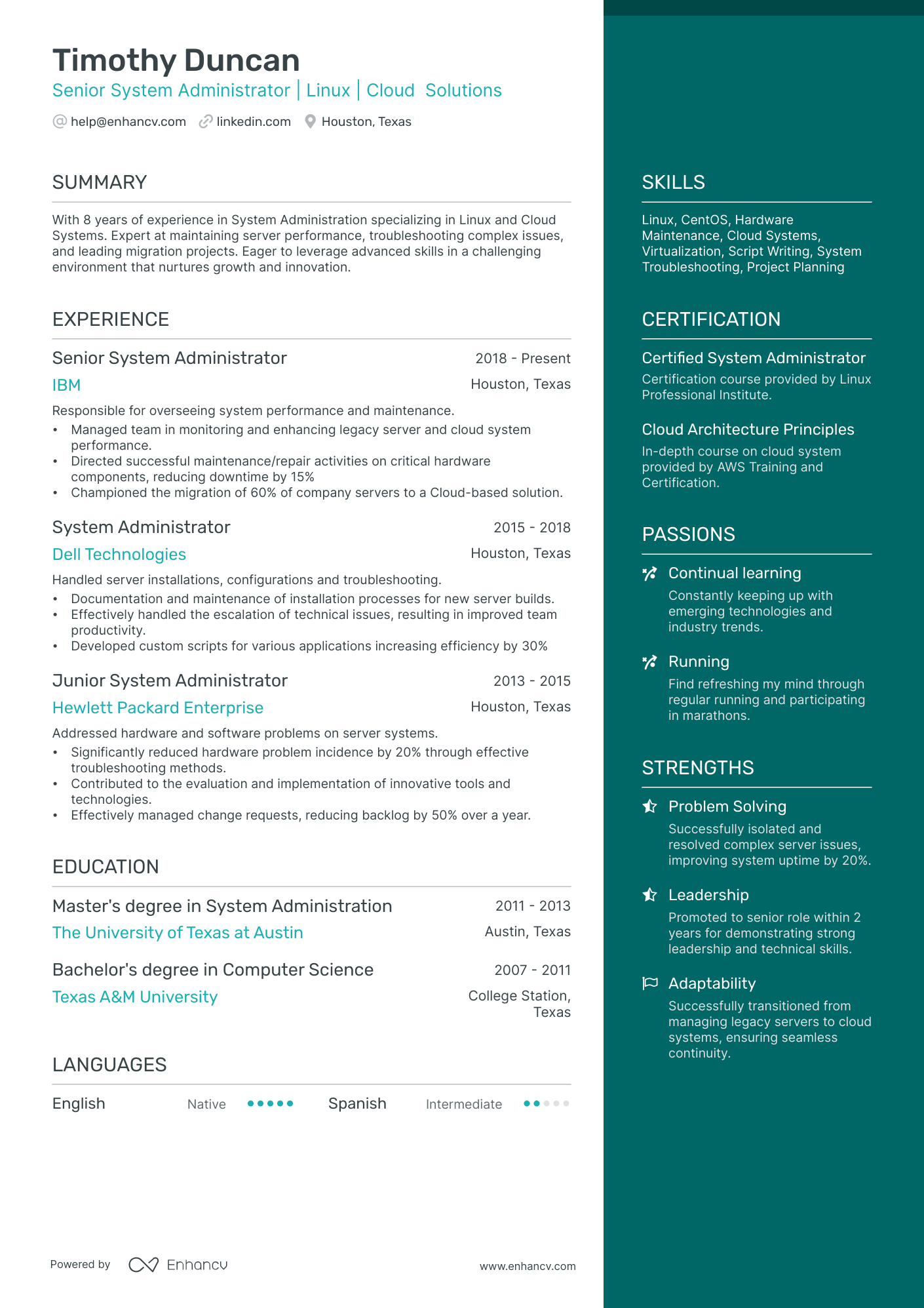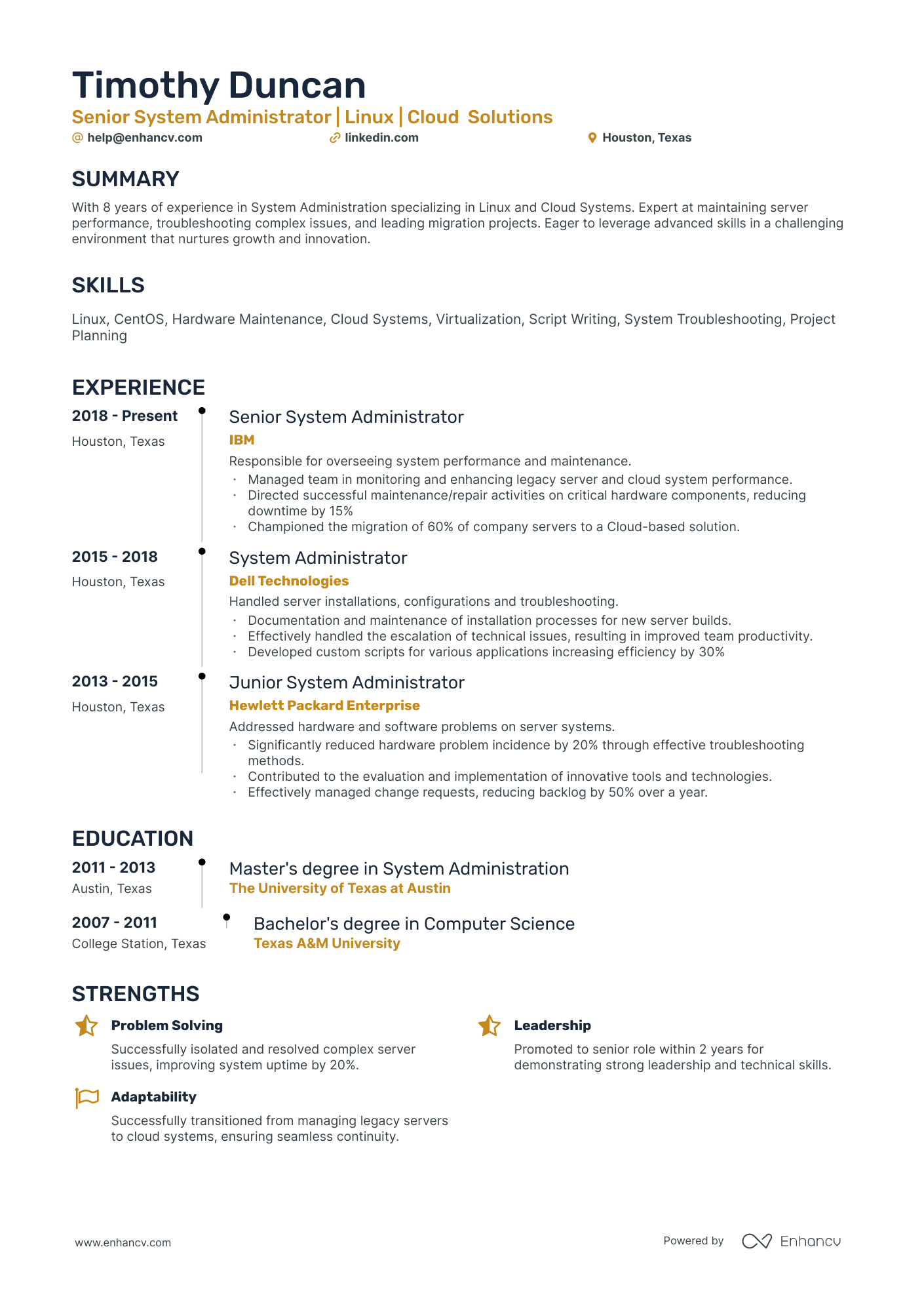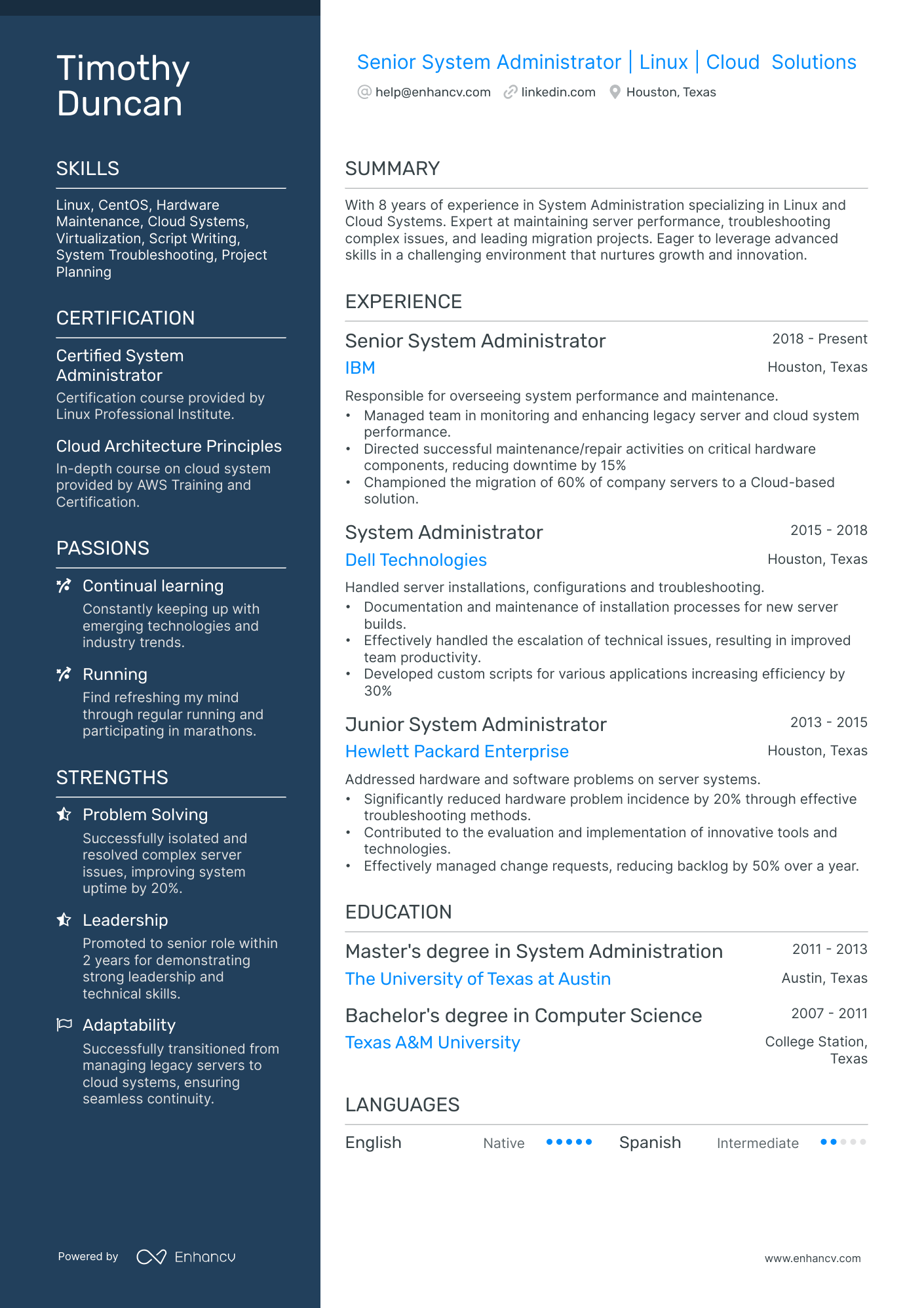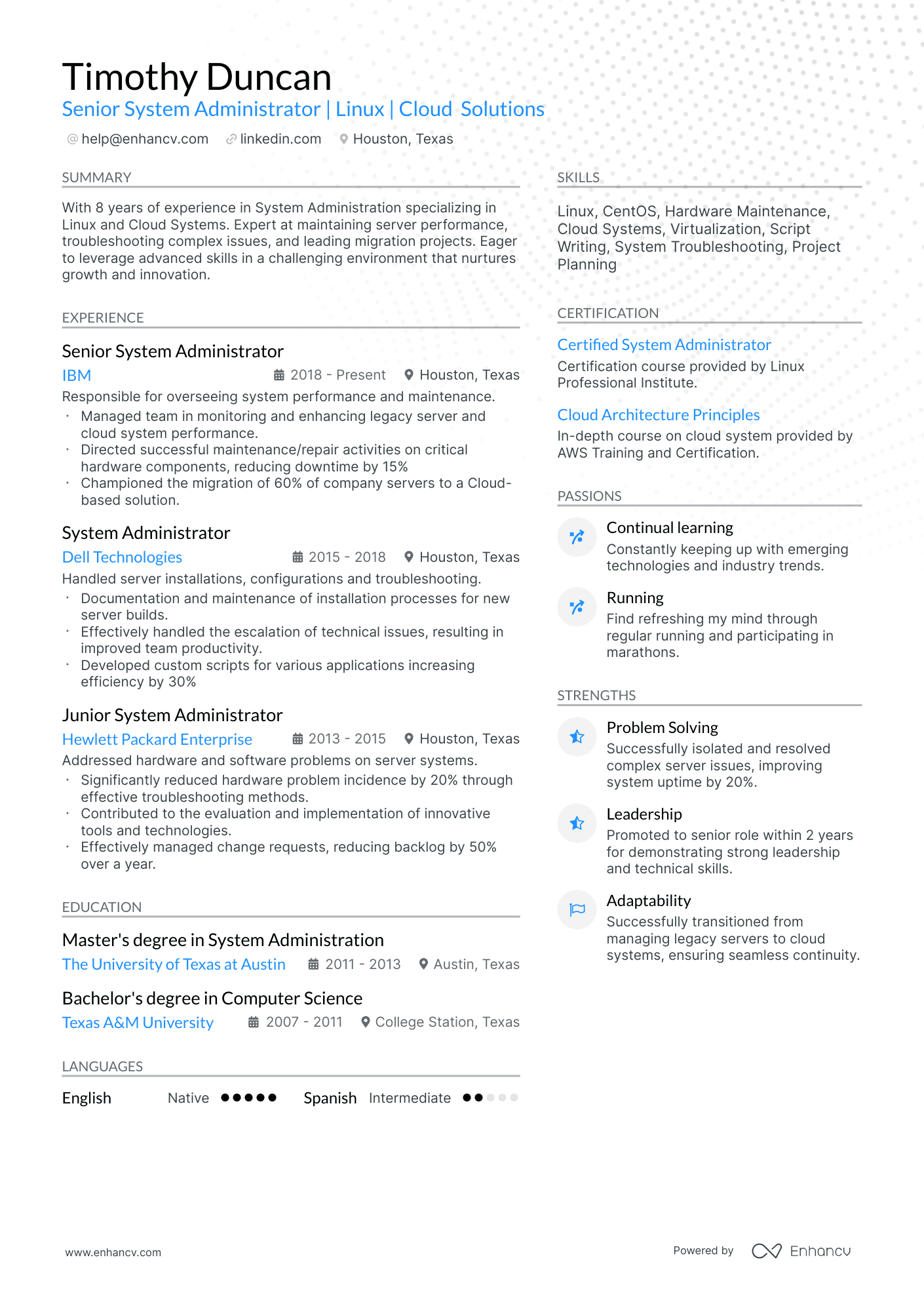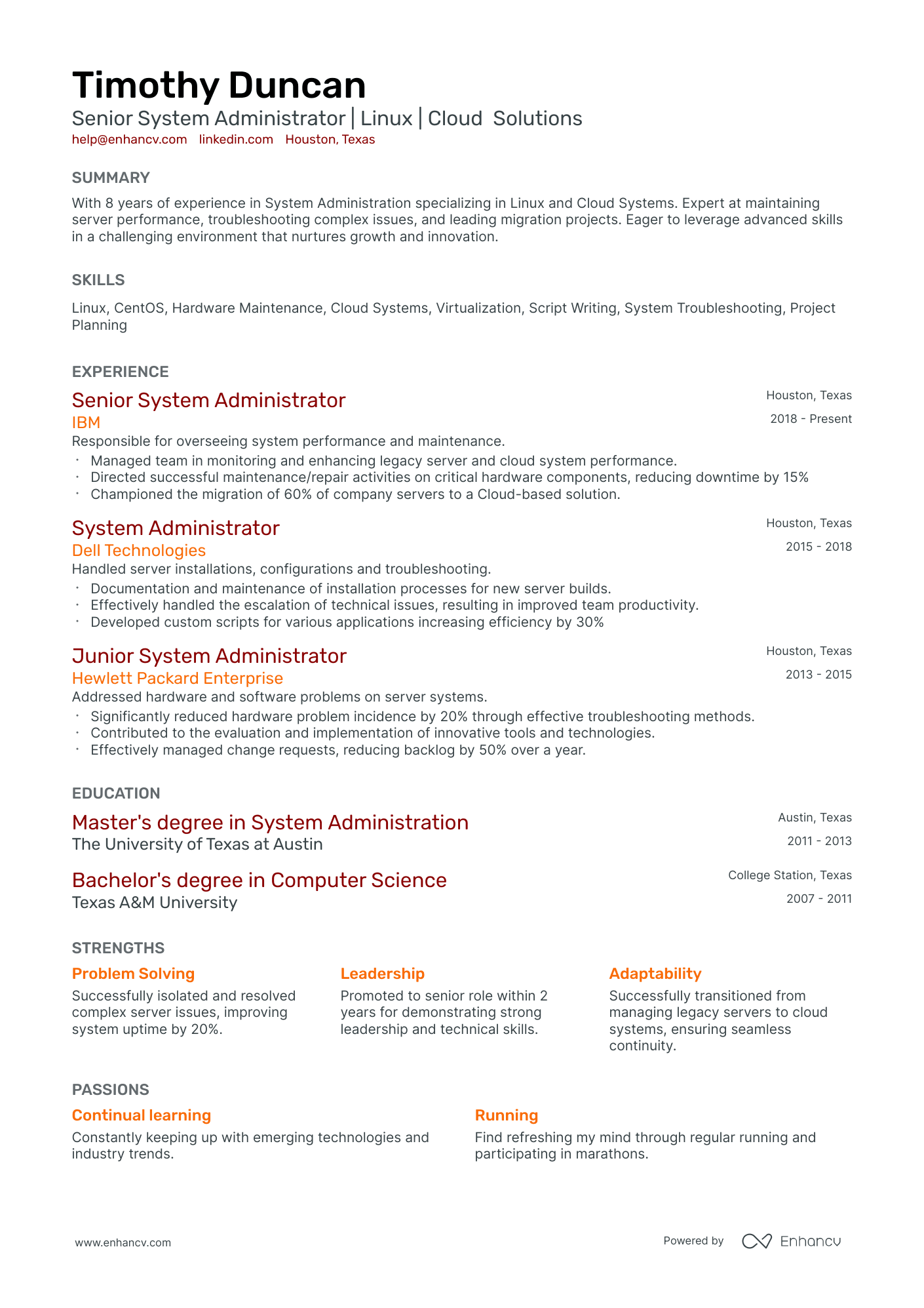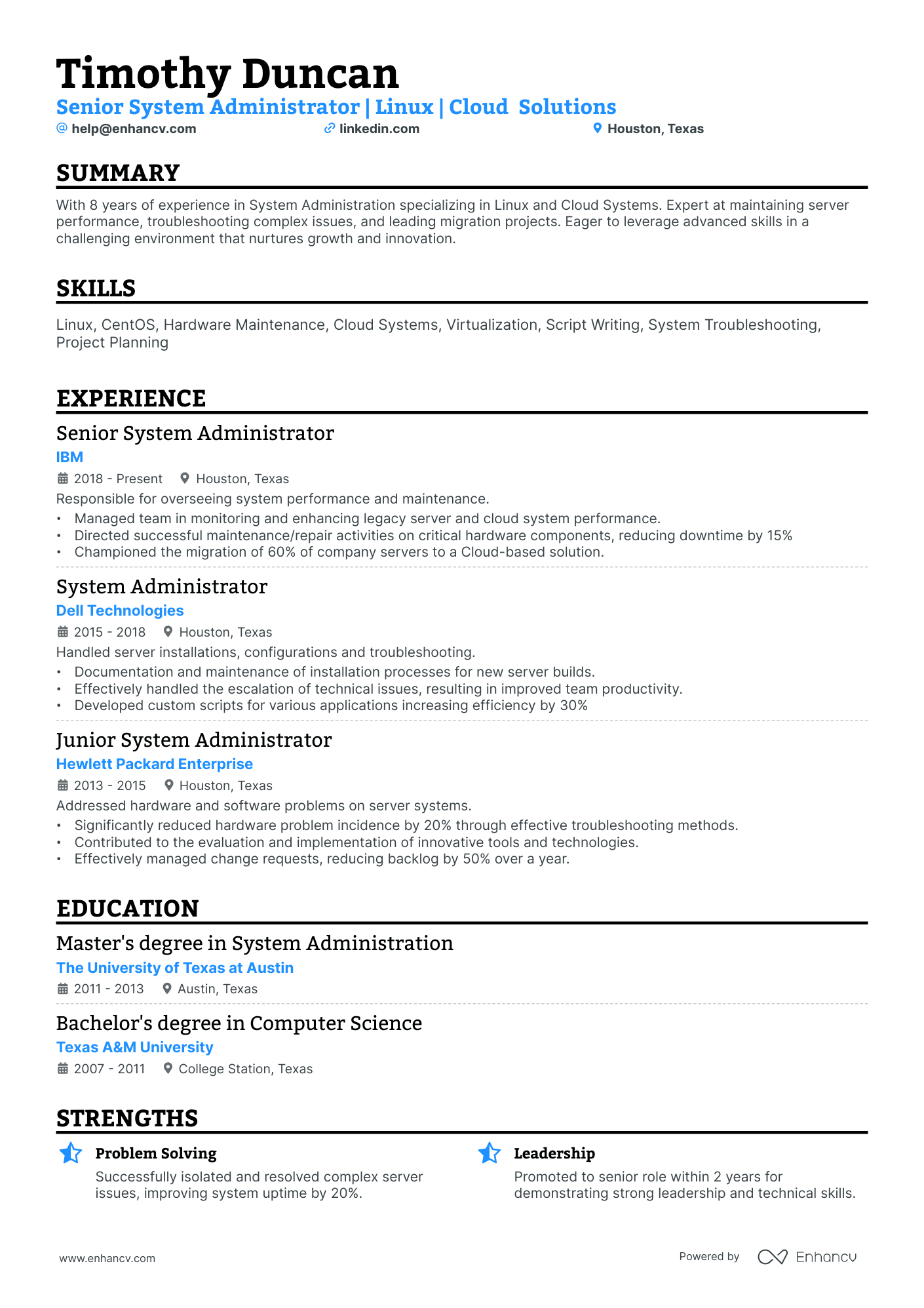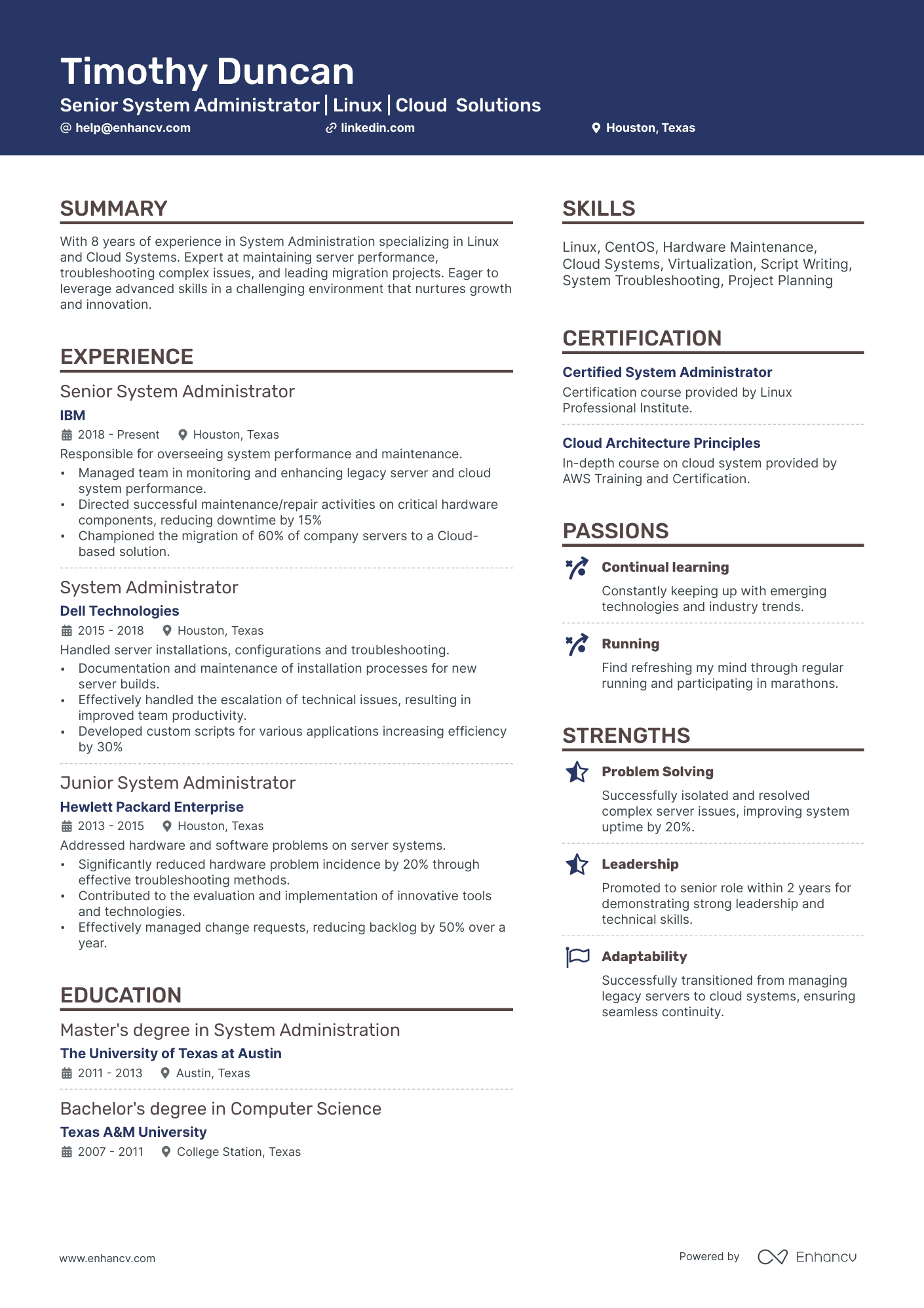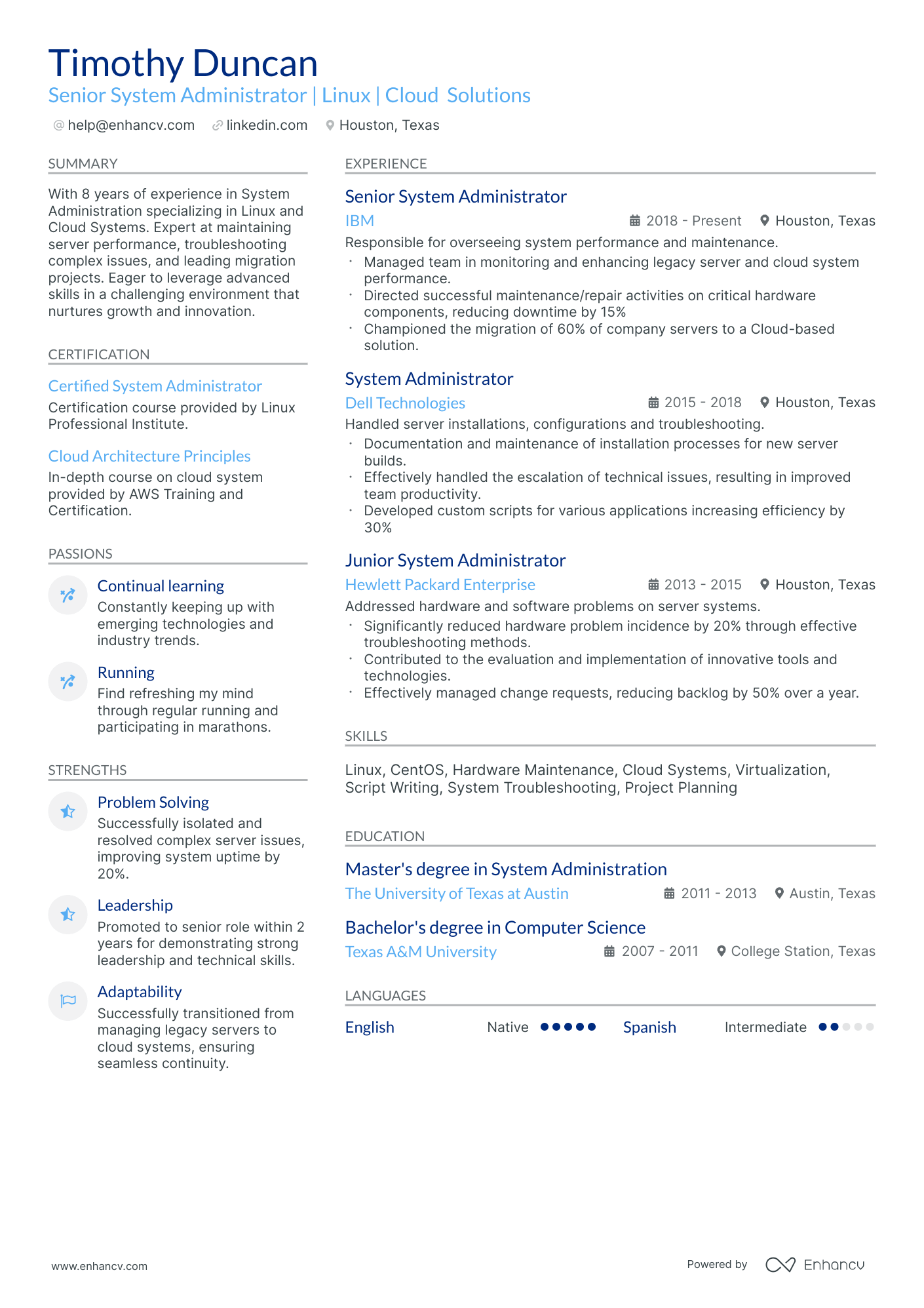A common resume challenge faced by a Linux system administrator is effectively showcasing their technical skills and experience in a clear, concise manner that aligns with the needs of potential employers. Our guide can assist in addressing this challenge by offering specific examples of how to articulate technical prowess, providing tailor-made Linux system administration resume templates, and giving advice on how to customize each section to match job descriptions precisely.
Dive into this guide to learn how to craft a Linux system administrator resume that offers recruiters a clear view of your career journey:
- Draw from our Linux system administrator resume samples, highlighting top skills, certifications, and more.
- Illuminate the potential impact you can bring to an organization through your resume summary and experience.
- Spotlight your unique Linux system administrator expertise, emphasizing tangible results and standout achievements.
Recommended reads:
Designing your Linux system administrator resume: best practices
Before penning down your Linux system administrator resume, consider its structure and format. Here's what you should remember:
- Employ the reverse-chronological format to present your experience, starting with your most recent role.
- Your resume's header should feature accurate, professional contact details. If you maintain a professional portfolio or LinkedIn profile, include its link.
- Keep your resume concise, ideally within two pages. Prioritize relevance over length.
- Unless directed otherwise, save your resume as a PDF to preserve its design.
Upload your resume
Drop your resume here or choose a file. PDF & DOCX only. Max 2MB file size.
Pro tip
Prioritize clarity and organization in your Linux system administrator resume. Use ample white space, choose readable fonts, and clearly delineate each section.
Recruiters' top picks for Linux system administrator resume sections:
- A header with essential contact details and a headline showcasing your current role.
- A summary or objective that aligns your standout expertise with the role's demands.
- An experience section that delves into your key responsibilities and achievements.
- A skills section that intertwines job requirements with your unique capabilities.
- Education and certifications sections that bolster your professional credentials.
What recruiters want to see on your resume:
- Proficiency in Linux distributions like Ubuntu, CentOS, or Fedora.
- Experience with shell scripting and automation tools such as Ansible, Chef, or Puppet.
- Knowledge of networking protocols, firewall management, and security practices in a Linux environment.
- Hands-on experience with Linux server setup, configuration, and maintenance including web servers, database servers, and email servers.
- Demonstrated abilities in problem-solving, troubleshooting system issues, and performance tuning of the Linux servers.
Recommended reads:
How to create the cornerstone experience section of your Linux system administrator resume
A meticulously crafted Linux system administrator resume experience section is a recruiter's delight. This segment not only responds to job criteria but also throws light on your technical expertise and character.
To craft an impactful experience section:
- Highlight roles directly related to the position in question.
- Pair each role or task with a metric that quantifies your achievements.
- Chronicle your Linux system administrator career progression, illustrating your dedication and growth in the domain.
- For each role, elucidate challenges faced, strategies employed, and the broader organizational impact.
Examine the following Linux system administrator samples to discern how seasoned professionals have articulated their experiences:
- Managed and maintained Linux servers, ensuring uninterrupted operations for 50+ employees.
- Implemented automation scripts using Bash and Python, resulting in a 30% reduction in manual tasks.
- Collaborated with the development team to deploy and configure web applications on Apache and Nginx servers.
- Supported a large-scale Linux-based infrastructure serving 500+ users across multiple locations.
- Performed system upgrades and patch management, minimizing vulnerabilities and enhancing security.
- Developed backup and recovery strategies, reducing data loss by 40% during critical incidents.
- Administered Linux servers hosting mission-critical applications, maintaining 99.9% uptime.
- Optimized server performance by fine-tuning kernel parameters and implementing load balancing.
- Led the migration of legacy systems to virtualized environments, improving scalability and resource utilization.
- Provided technical support to end-users, resolving Linux-related issues and ensuring smooth operations.
- Implemented monitoring tools such as Nagios to proactively identify and address system bottlenecks.
- Managed user accounts, permissions, and access control in compliance with company policies.
- Designed and implemented a centralized logging system using ELK Stack, enabling efficient log analysis.
- Performed vulnerability assessments and implemented security hardening measures across Linux infrastructure.
- Collaborated with cross-functional teams to plan and execute disaster recovery exercises successfully.
- Supported Linux-based development environments by configuring tools like Git and Jenkins for streamlined workflows.
- Managed database systems, including installation, optimization, and troubleshooting of MySQL and PostgreSQL.
- Deployed scalable web applications using Docker containers, resulting in improved deployment times.
- Administered Linux clusters for high-performance computing, optimizing resource allocation and job scheduling.
- Developed and maintained custom shell scripts for automating system administration tasks.
- Collaborated with research teams to deploy specialized scientific software packages on Linux servers.
- Implemented Kubernetes orchestration for containerized applications, enhancing scalability and fault tolerance.
- Designed and managed multi-site Linux server infrastructure, ensuring high availability and disaster recovery.
- Led the implementation of Ansible for configuration management, reducing deployment time by 50%.
- Upgraded Linux servers from CentOS 6 to CentOS 7, resulting in improved performance and security.
- Managed LDAP directory services, including user authentication, access control, and SSL certificate management.
- Implemented log rotation and retention policies, complying with industry regulations and ensuring auditability.
- Maintained and supported Linux-based email servers, ensuring reliable communication for 1,000+ users.
- Performed system monitoring and capacity planning to meet growing demands and optimize resource allocation.
- Assisted in the migration of physical servers to virtualized environments using VMware technology.
Quantifying impact on your resume
<ul>
Addressing a lack of relevant Linux system administrator experience
Even if you lack direct Linux system administrator experience, you can still craft a compelling resume. Here's how:
- Highlight projects or publications that demonstrate your relevant skills or knowledge.
- Emphasize transferable skills, showcasing your adaptability and eagerness to learn.
- In your objective, outline your career aspirations and how they align with the company's goals.
- Consider a functional or hybrid resume format, focusing on skills over chronological experience.
Pro tip
If your experience section doesn't directly address the job's requirements, think laterally. Highlight industry-relevant awards or positive feedback to underscore your potential.
Essential Linux system administrator resume skills
When recruiters review Linux system administrator resumes, they're looking for a mix of technical know-how and personal attributes.
Technical skills demonstrate your proficiency in specific tools or tasks. They indicate if you're ready to jump into the role or if you'll need extensive training.
On the other hand, soft skills reflect your interpersonal abilities. They show how you'll fit into a team or company culture.
To effectively present these skills on your resume:
- Design a skills section that highlights both your technical and interpersonal strengths.
- Provide examples where you've applied these skills, such as projects or tasks.
- For soft skills, describe situations where they've been crucial to your success.
- Use metrics, like improved efficiency or positive feedback, to validate your skills.
For inspiration, explore the preferred skills of leading Linux system administrator professionals.
Top skills for your Linux system administrator resume:
Linux system administration
Shell scripting
Network configuration
System security measures
Troubleshooting skills
Database management (MySQL, PostgreSQL)
Knowledge of virtualization technologies (VMware, KVM)
Configuration management (Ansible, Puppet, Chef)
Version control systems (Git)
Cloud platforms (AWS, GCP, Azure)
Problem-solving
Team collaboration
Communication skills
Time management
Adaptability
Detail-oriented
Critical thinking
Ability to work under pressure
Patience
Continuous learning
Pro tip
If the job emphasizes team or organizational culture, dedicate a section of your resume to underscore your strengths and achievements. Top-tier Linux system administrator candidates also highlight their alignment with a company's values and culture.
Highlighting education and certification on your Linux system administrator resume
Your education section is a testament to your foundational knowledge and expertise.
Consider:
- Detailing your academic qualifications, including the institution and duration.
- If you're still studying, mention your anticipated graduation date.
- Omit degrees that aren't pertinent to the job.
- Highlight academic experiences that underscore significant milestones.
For Linux system administrator roles, relevant education and certifications can set you apart.
To effectively showcase your qualifications:
- List all pertinent degrees and certifications in line with the job requirements.
- Include additional certifications if they bolster your application.
- Provide concise details: certification name, institution, and dates.
- If you're pursuing a relevant certification, indicate your expected completion date.
Your education and certification sections validate both your foundational and advanced knowledge in the industry.
Best certifications to list on your resume
Pro tip
Listing your relevant degrees or certificates on your Linux system administrator resume is a win-win situation. Not only does it hint at your technical capabilities in the industry, but also at a range of soft skills, including perseverance, adaptability, and motivation.
Recommended reads:
Choosing between a resume summary or objective
Many Linux system administrator candidates ponder whether to include a resume summary or objective.
Here's a breakdown:
- A Resume objective outlines your career aspirations. It tells recruiters why you're applying and the value you can bring.
- A Resume summary offers a snapshot of your significant achievements, giving a quick overview of your expertise.
New professionals might lean towards an objective, while seasoned experts might prefer a summary. Whichever you choose, ensure it's tailored to the role.
For inspiration, review examples from established Linux system administrator professionals.
Resume summary and objective examples for a Linux system administrator resume
Experienced Linux system administrator with 7 years under my belt, adept at Red Hat system administration alongside robust scripting skills in Python and Bash. I pride myself on having implemented automation strategies that increased operational efficiency by 30% at X Corp.
Enthusiastic professional with 5 years of experience as a Windows System Administrator, keen to transition to a Linux environment. Having earned numerous accolades for successfully managing large server farms, I am eager to leverage these skills to ensure optimal server performance and reliability in the Linux domain.
As a seasoned network engineer with 8 years of experience, I'm excited to switch gears into Linux System Administration. I bring with me profound knowledge of networking protocols and security practices, and have proven track records in troubleshooting complex network issues. I aim to drive secure, reliable network operations on Linux systems.
Software developer with a 6-year journey, now seeking to contribute my extensive coding skills in Python and Java towards a Linux system administrator role. Acclaimed for developing an award-winning application, I possess a strong foundation in software development and Linux environments that will enable effective management of Linux systems.
Although new to the field of Linux System Administration, I am excited to apply my comprehensive understanding of Computer Science principles and passion for technology to manage and optimize Linux servers for maximum uptime and stability.
Eager to enter the world of Linux System Administration, I am fully prepared to utilize my degree in Information Technology alongside my knack for problem-solving. My goal is to provide robust support to Linux-based infrastructure, ensuring continuity, and maintaining high standards of service.
Extra sections to boost your Linux system administrator resume
Add more sections to show off your unique skills and personality.
- Projects - Include any impressive ones you've done outside of work.
- Awards - Show off any industry recognition.
- Volunteering - Share causes you care about and skills you've gained.
- Personality - Hobbies or favorite books can give a glimpse into who you are.
Key takeaways
- The format and layout of your Linux system administrator resume should reflect your career experience;
- Use the resume summary and objective to highlight your most prominent accomplishments;
- Always be specific about your experience and consider what value each bullet adds to your Linux system administrator application;
- Consider how your academic background and technical capabilities could further showcase your alignment to the role;
- Your soft skills should contribute to your overall Linux system administrator profile - aligning your personality with your professional self.
